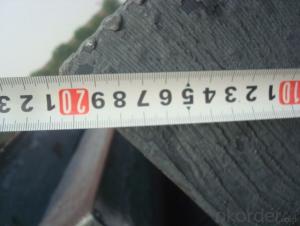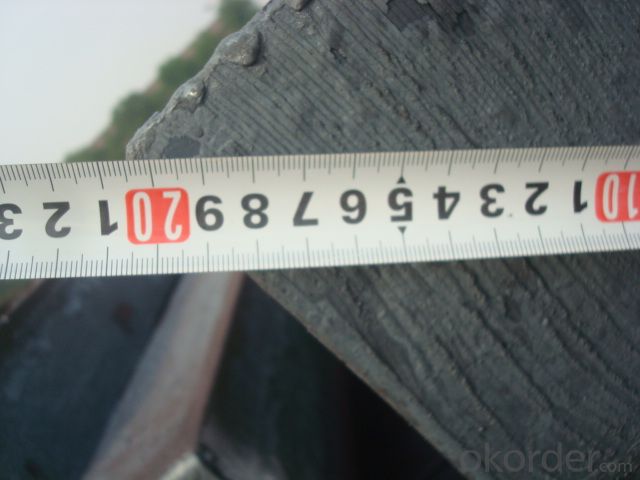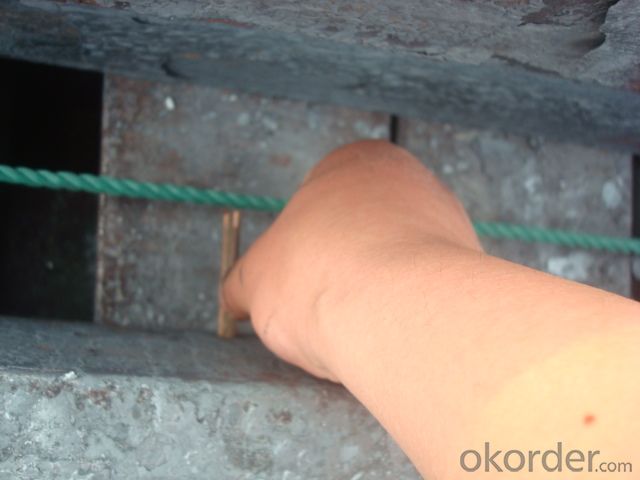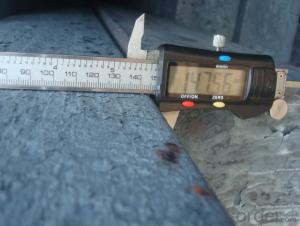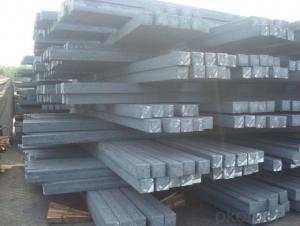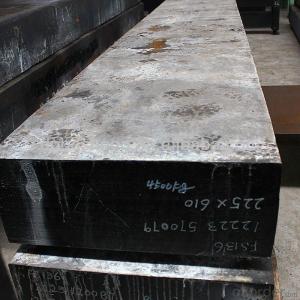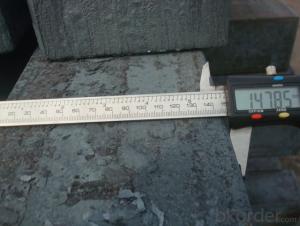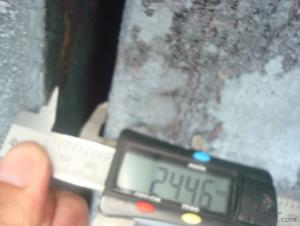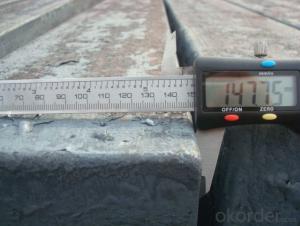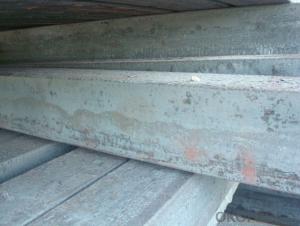Alloyed Steel Bloom/Billet Manufactured by Blast Furnace by Continue Casting Making
- Loading Port:
- Tianjin
- Payment Terms:
- TT OR LC
- Min Order Qty:
- 1000 m.t.
- Supply Capability:
- 10000 m.t./month
OKorder Service Pledge
OKorder Financial Service
You Might Also Like
Alloyed Steel Bloom/Billet Manufactured by Blast Furnace by Continue Casting Making
1.Structure of Alloyed Steel Bloom/Billet Manufactured by Blast Furnace by Continue Casting Making
Steel Billets Manufactured by Continue Casting is the raw material of all kinds of steel mill. Billet section of square, round, flat, rectangular and abnormity, etc Several, mainly related to shape of rolled products. Simple rolled section steel, choose cross section of square billet or rectangular billet. rolling The sector products such as flat steel, Angle steel, select the rectangular billet or slab. Had better profiled billet when production beams, channels, and in rolling process Lines and improve the yield. The raw material of round billet is the production of seamless tube.
2.Main Features of Alloyed Steel Bloom/Billet Manufactured by Blast Furnace by Continue Casting Making.
There are three shapes of the steel billets: square billet, slab, rectangular billet The Chinese billet, rectangular billet is mainly suitable for rolling hot rolled strip, building reinforced bar, Ordinary wire, high speed wire rod and various small profile. Of the slab are mainly used for rolling plate and hot coil sheet.
3. Alloyed Steel Bloom/Billet Manufactured by Blast Furnace by Continue Casting Making Images
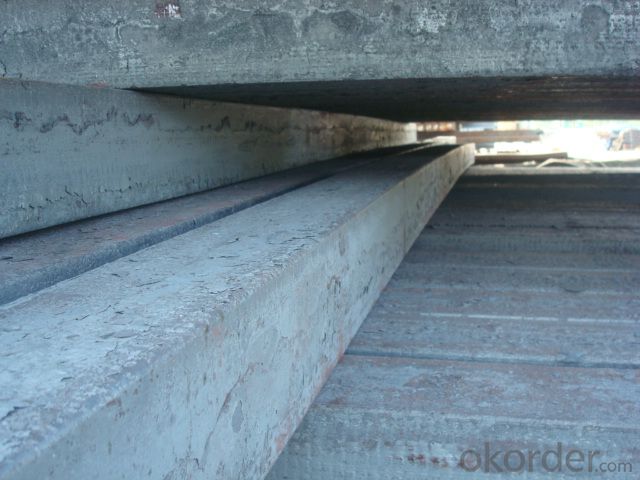
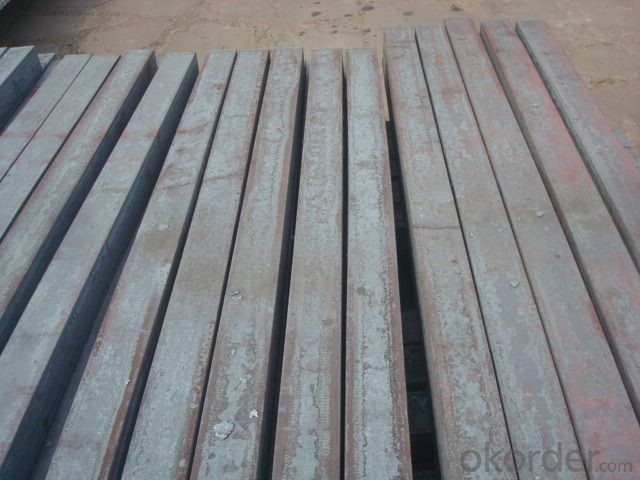
4. Alloyed Steel Bloom/Billet Manufactured by Blast Furnace by Continue Casting MakingSpecification
Material standard The editor Range of thickness: 150-240 - mm + / - 5 mm width range: 880-1530 - mm + / - 20 mm Length: 3700-10000 - mm + / - 500 - mm Cross-sectional size: 64 * 64; 82 * 82; 98 * 98; 124 * 124; 120 * 150; 152 * 164; 152 * 170 mm Length: 9000 mm Section of tolerance: billet: 1.0 + / - 2.0-1.0 + / - 1.0 mm slab: width: + / - 2.0 mm thickness: + / - 3.0 mm The length tolerance: + / - 200 mm Section diagonal tolerance: 3.5-8.0 MM Billet section size protrusions requirements: < 1242 mm, do not allow; > = 1242 mm, < = 2 mm 1242 mm, < = 3 mm Beheading (shear) extension deformation: < 1242 mm billet: no control; The slab: < = 15 mm Surface tilt: no more than billet section 0.1 Bending: every 1 m length is not more than 10 mm The distortion: length < = 5 m, < = 11. ; The length of the < = 7.5 M, < = 5. Material % 3 sp/PS chemical composition: C Mn Si S P
5.FAQ of Alloyed Steel Bloom/Billet Manufactured by Blast Furnace by Continue Casting Making
We have organized several common questions for our clients,may help you sincerely:
①How about your company?
A world class manufacturer & supplier of castings forging in carbon steel and alloy steel,is one of the large-scale professional investment casting production bases in China,consisting of both casting foundry forging and machining factory. Annually more than 8000 tons Precision casting and forging parts are exported to markets in Europe,America and Japan. OEM casting and forging service available according to customer’s requirements.
②By affecting the processing product performance points, what type of inclusions? According to the inclusion, plastic deformation can be divided into brittle inclusions inclusions and half plastic inclusions. Brittle inclusions generally refers to those who do not have plastic deformation capacity, complex and simple oxide composite oxides, nitride and deformation of spherical, dot inclusions.Because the wire is the billet hot rolled into wire rod by drawing again after formed, request the deformation is large, so A1203, spinel, such as deformation brittle inclusions is very big to the harm of wire rod. Inclusions in steel processing through plastic deformation when have good plasticity, extends along the flow direction of the steel slits, belong to this class of SiO2 content low iron silicate, iron sulfide, manganese (Fe, Mn) S, etc.Half of the plastic inclusions generally refers to all kinds of compound aluminum silicate inclusions. Deformation behavior of non-metallic inclusions in steel is more complex, not only depend on the type of inclusions, and is closely related to the inclusion composition and deformation temperature.
③What is the advantage of the continue Casting steel billet comparing to the die casting steel billet?
Compared with die casting, continuous casting has the advantages of: 1. To simplify the Steel billet The production process 2. Improve the metal yield 3. Improve the quality of the billet 4. Reduces the steel worker's labor intensity 5. Save energy and reduce consumption
Steel billet is produced by the method of through three processes: It is through the steelmaking system of continuous casting equipment, directly by the molten steel pouring into billet; The second is the steelmaking system in the production of steel ingot casting billet through system of steel rolling rolling equipment or processing of steel semi-finished products; Three is the steelmaking system production of steel ingot by forging the semi-finished product processing equipment.
- Q: What are the main factors affecting the tensile strength of steel billets?
- The main factors affecting the tensile strength of steel billets include the chemical composition of the steel, the heat treatment process, the presence of impurities or defects in the material, the grain size and orientation, and the processing conditions used during manufacturing.
- Q: How are steel billets used in the production of automotive chassis?
- Automotive chassis production relies heavily on steel billets, which are integral for creating the necessary components. These billets are cast from molten steel into rectangular or square shapes and then processed further. Initially, the steel billets undergo hot rolling, a procedure that involves heating them to high temperatures and passing them through rollers to shape them accordingly. This elongates the billets and gives them different profiles, such as I-beams or C-channels, which are commonly used in automotive chassis construction. Once the desired shape is achieved, the hot-rolled steel goes through quenching and tempering. This process rapidly cools the steel in a controlled manner, enhancing its strength and durability. The steel is then reheated and slowly cooled to stabilize its microstructure, resulting in improved mechanical properties. Next, the processed steel billets are cut into specific lengths and welded together to create the main structural components of the automotive chassis, including the frame and subframe. These components provide the necessary strength, rigidity, and stability to support the vehicle and endure the various loads and stresses encountered during operation. Steel billets are favored in automotive chassis production due to their excellent strength-to-weight ratio, high tensile strength, and ability to withstand impact and bending forces. These characteristics ensure the safety and stability of the vehicle, as well as provide a solid foundation for other automotive components like suspension systems, engine mounts, and body panels. In summary, steel billets are essential in the production of automotive chassis as they serve as the raw material for creating various structural components. Their strength, durability, and versatility make them the preferred choice in the automotive industry, guaranteeing that vehicles are built to endure the demands of everyday use and offer a safe and reliable driving experience.
- Q: What is the price range of steel billets?
- The price range of steel billets can vary depending on various factors such as the quality of the steel, market demand, and global economic conditions. However, on average, steel billets can range in price from $400 to $800 per metric ton.
- Q: What is the typical composition of steel billets?
- The typical composition of steel billets consists of primarily iron and carbon, with small amounts of other elements such as manganese, silicon, and sulfur.
- Q: How are steel billets used in the manufacturing of railway tracks?
- Steel billets are used in the manufacturing of railway tracks by being heated and shaped into long, thick bars. These bars are then further processed, including cutting, drilling, and shaping, to form the individual sections of the track. The high strength and durability of steel billets make them suitable for withstanding the heavy loads and constant wear and tear experienced by railway tracks.
- Q: How is the quality of steel billets determined?
- The quality of steel billets is determined through a combination of physical and chemical tests. These tests are performed to ensure that the steel meets the required standards and specifications for its intended use. One of the primary methods to determine the quality of steel billets is through chemical analysis. This involves testing the composition of the steel to ensure it meets the desired levels of different elements such as carbon, manganese, silicon, and others. The chemical composition plays a crucial role in determining the strength, hardness, and other mechanical properties of the steel. In addition to the chemical analysis, various physical tests are conducted to assess the quality of steel billets. These tests include measuring the dimensions, weight, and straightness of the billets to ensure they meet the specified tolerances. Surface inspection is also performed to detect any defects, such as cracks, seams, or surface irregularities that could affect the performance of the steel. Mechanical tests are another crucial aspect of determining the quality of steel billets. These tests evaluate the mechanical properties of the steel, including its strength, ductility, toughness, and hardness. Tensile tests are commonly conducted to measure the maximum load a steel billet can withstand before breaking or deforming. Impact tests are also performed to assess the steel's ability to resist sudden shocks or impacts. Furthermore, non-destructive testing techniques are used to detect any internal defects or inconsistencies in the steel billets. These methods include ultrasonic testing, magnetic particle inspection, and radiographic testing. These tests help ensure that the steel is free from any hidden defects that could compromise its quality or structural integrity. Overall, the quality of steel billets is determined through a comprehensive evaluation that includes chemical analysis, physical tests, mechanical tests, and non-destructive testing. These methods ensure that the steel meets the required standards and specifications, providing assurance of its reliability and suitability for various applications.
- Q: What is the typical impact strength of a steel billet?
- The impact strength of a steel billet typically varies based on the grade and composition of the steel. Generally, steel billets have a high level of toughness and can endure significant impact forces without fracturing or breaking. This is because steel possesses inherent strength and ductility. Nevertheless, it is important to acknowledge that the impact strength of a steel billet can be further improved through various methods like heat treatment or alloying. These techniques assist in enhancing the material's resistance to impact, making it more durable and suitable for demanding applications. Essentially, to determine the exact impact strength of a steel billet, it is crucial to consider the specific grade and composition. Different steel grades are designed for different purposes, and consequently, their impact strength can vary. Therefore, it is advisable to consult the manufacturer or refer to the material specifications to obtain accurate and detailed information regarding the typical impact strength of a particular steel billet.
- Q: What are the common challenges in steel billet production?
- There are several common challenges in steel billet production that manufacturers often face. One of the primary challenges is maintaining consistent quality throughout the production process. Steel billets need to meet specific standards and specifications in terms of chemical composition, mechanical properties, and surface finish. Any deviation from these requirements can lead to rejection of the billets, causing delays and additional costs. Therefore, ensuring consistent quality control throughout the production cycle is crucial. Another challenge is achieving the desired size and shape of the billets. Steel billets come in various sizes and shapes, depending on the intended use. Producing billets with accurate dimensions and shape requires precision and careful calibration of the equipment involved in the production process. Any deviation in size or shape can result in difficulties during downstream processes, such as rolling or forging, and may lead to product defects or inefficiencies. Maintaining efficient production rates is also a common challenge. Steel billet production often involves complex and time-consuming processes, such as melting, casting, and cooling. Any disruption or bottleneck in these processes can significantly impact the production rate and overall efficiency. It is crucial to optimize the production flow and identify and address any bottlenecks in order to meet demand and minimize production delays. Controlling energy consumption and minimizing waste is another challenge in steel billet production. The production of steel billets requires high energy inputs, such as electricity and fuel. Finding ways to reduce energy consumption and optimize the use of resources can help minimize production costs and environmental impact. Additionally, minimizing waste generation and implementing effective recycling or reusing strategies can further enhance the sustainability of the production process. Lastly, ensuring the safety of workers and maintaining a safe working environment is a critical challenge in steel billet production. The production process involves working with heavy machinery, high temperatures, and potentially hazardous materials. Implementing robust safety protocols, providing appropriate personal protective equipment, and conducting regular safety audits are essential to prevent accidents and ensure the well-being of the workforce. Overall, steel billet production faces challenges related to maintaining consistent quality, achieving accurate size and shape, maintaining efficient production rates, controlling energy consumption, and ensuring worker safety. Overcoming these challenges requires continuous improvement, investment in technology and equipment, and a commitment to quality control and safety measures.
- Q: What are the different types of steel billet reheating furnaces?
- There are several different types of steel billet reheating furnaces used in the metal industry. These furnaces are designed to heat steel billets to a specific temperature before they are further processed or shaped into various end products. The main types of steel billet reheating furnaces include: 1. Pusher Type Furnace: This type of furnace uses a pusher mechanism to move the billets through the furnace. The billets are loaded onto a roller conveyor and pushed into the furnace using mechanical pusher plates. As the billets move through the furnace, they are heated by the combustion gases or electrical heating elements. 2. Walking Beam Furnace: In a walking beam furnace, the billets are placed on a series of moving beams or skids. These beams move in a continuous loop, carrying the billets through the furnace. As the billets move, they are heated by the burners or electrical heating elements located above and below the beams. 3. Rotary Hearth Furnace: This type of furnace consists of a rotating hearth on which the billets are placed. The hearth rotates, bringing the billets through different temperature zones within the furnace. The billets are heated by the burners or electrical heating elements located above the hearth. 4. Continuous Furnace: A continuous furnace is a type of furnace where the billets are continuously fed into one end and discharged from the other end. The billets move through the furnace on a conveyor belt or roller conveyor, being heated by the combustion gases or electrical heating elements as they pass through. 5. Walking Hearth Furnace: In a walking hearth furnace, the billets are placed on a hearth that moves in a reciprocating motion. The hearth moves back and forth, bringing the billets through the furnace. The billets are heated by the burners or electrical heating elements located above and below the hearth. Each type of steel billet reheating furnace has its own advantages and is suitable for specific applications. The choice of furnace depends on factors such as the required heating capacity, the size and shape of the billets, the desired temperature profile, and the energy efficiency requirements.
- Q: How are steel billets used in the production of power generation equipment?
- The strength, durability, and versatility of steel billets make them essential in the manufacturing of power generation equipment. This equipment, which includes turbines and generators, requires robust and dependable components to withstand tough operating conditions and ensure uninterrupted power supply. Steel billets, small semi-finished steel products, serve as the raw material for producing different parts of power generation equipment. They are melted and cast into specific shapes to create turbine blades, shafts, casings, and rotors. The utilization of steel billets in power generation equipment guarantees strong structural integrity due to the excellent mechanical properties of steel. It possesses high tensile strength, enabling it to endure extreme rotational forces and pressures within turbines and generators. Moreover, steel has good resistance against corrosion and high temperatures, making it ideal for use in power generation equipment that operates in harsh environments. Additionally, steel billets can be easily machined and welded, allowing for precise manufacturing and assembly of intricate parts. This adaptability in shaping and joining steel billets facilitates the production of customized components tailored to the specific requirements of power generation equipment. In conclusion, steel billets are crucial in the manufacturing of power generation equipment as they provide a robust, durable, and versatile material for creating various components. Their use ensures the reliability and durability of power generation equipment, enabling efficient and uninterrupted power generation.
Send your message to us
Alloyed Steel Bloom/Billet Manufactured by Blast Furnace by Continue Casting Making
- Loading Port:
- Tianjin
- Payment Terms:
- TT OR LC
- Min Order Qty:
- 1000 m.t.
- Supply Capability:
- 10000 m.t./month
OKorder Service Pledge
OKorder Financial Service
Similar products
Hot products
Hot Searches
Related keywords
